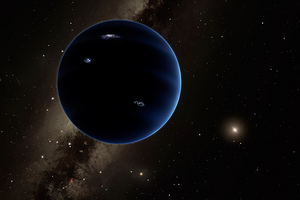'Planet Nine' conjecture exciting, but not proven, says NASA
The proposal that our solar system may harbor a ninth planet, one about 10 times more massive than Earth, is certainly exciting, says NASA, but the agency cautions that no planet has yet been detected.

Planet Nine: Artist’s Concept
Caltech/R. Hurt (IPAC)
The news that a planet about 10 times more massive than Earth may orbit the sun somewhere beyond Neptune has stirred up incredible excitement among scientists and the general public.
But hold the phone — no planet has been discovered yet. In a video released by NASA, Jim Green, NASA's director of planetary science, cautions that it is still too early to claim that Earth's solar system has nine planets (again).
"The idea of a new planet is certainly an exciting one for me as a planetary scientist, and I think for all of us," Green said in the video. "It is not, however, the detection of a new planet. It's too early to say with certainty that there is a so-called 'Planet X' out there." [The Evidence for Planet Nine in Pictures]
"Planet Nine" is the name scientists have given to a theorized body that, if it exists, lies about 20 times farther from the sun than Neptune does. That places it in the Kuiper Belt, a region of small, icy objects that includes Pluto.
The prediction of Planet Nine's existence came from a paper released on Wednesday (Jan. 20) that shows how the motion of some known bodies in the Kuiper Belt could be explained by the presence of such a massive planet.
But this is far from a direct detection. The prediction is based on solar system models that are built up and improved on using observational data but allow astronomers to look at what might exist beyond what has already been seen.
"The Jan. 20 paper in the Astronomical Journal is fueling our interest in planetary exploration, and fueling a debate that's part of the scientific process," Green said in the video. "It's all about starting the process that could lead to an exciting result."
Astronomers have said that if this planet exists, it should be fairly easy to find with telescopes like the Subaru Telescope in Hawaii, which has been used to find other distant objects in the solar system. A few months of scanning the sky in the region where the new planet is predicted to be might provide direct observational evidence of its existence, astronomers say.
But there is a possibility that Planet Nine doesn't exist and that some other explanation accounts for the motion of objects that astronomers observe in the Kuiper Belt. Whatever the outcome, Green said, the general public will have "a front row seat" for the show.
Follow Calla Cofield @callacofield. Follow us @Spacedotcom, Facebook and Google+. Original article on Space.com.
Copyright 2016 SPACE.com, a Purch company. All rights reserved. This material may not be published, broadcast, rewritten or redistributed.

